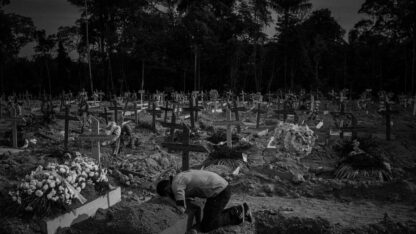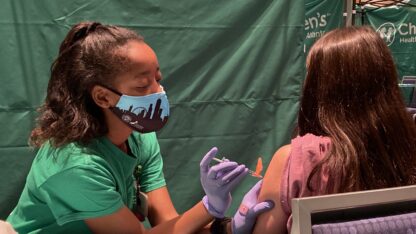A USA Today analysis shows that of the 10 counties in the nation with the highest death rates from COVID-19, five are in Georgia.
Hancock County is No. 1 on the list. The Middle Georgia county, with a death rate from COVID-19 of 45.7 per 10,000 residents, became a virus hot spot after outbreaks in two nursing homes, where at least 27 residents have died.
USA Today found that many counties with the highest COVID-19 death rates nationally have a majority of their populations being people of color. In Hancock County, three in four residents are in that demographic.
Among Georgia counties on the national death rate listing, Randolph at No. 3 and Terrell at No. 4 each have populations that are nearly two-thirds people of color, almost all of them African-Americans.
The county with the eighth-highest death rate, Early, has a population that consists of 54 percent minorities. Jenkins, which is 10th, has 44 percent people of color.
Each of these Georgia counties has had a major COVID outbreak at one or more nursing homes.
Twelve of the 50 U.S. counties with the highest death rates are in Georgia. None are in major metro areas, and Dougherty, home of the city of Albany, is the only one that’s not considered rural.
The Georgia counties have several elements in common, said Jimmy Lewis, CEO of HomeTown Health, an association of rural hospitals in the state. These factors include high levels of poverty and chronic disease, high uninsured rates, more older residents, and medical care deficits, he said.
The state Department of Public Health says COVID-19 has disproportionately affected racial and ethnic minority groups in Georgia and across the nation.
“Inequities in the social determinants of health, such as access to a quality education, poverty, and health care utilization/access put racial and ethnic minority groups at an increased risk of getting sick and dying from COVID-19,’’ Nancy Nydam, a Public Health spokeswoman, said Friday.
Rural areas are hit hardest by these inequities, she said. Public Health has created a team to examine the impact of COVID-19 on racial and ethnic groups in the state, and how to address these problems, Nydam added.
Enduring inequality
The USA Today investigation explored how past and current policies have made nonwhites prime targets for the virus.
Their analysis found:
** America’s education and economic systems are still unequal, disproportionately leaving people of color out of higher-wage jobs. When COVID-19 struck, more people of color were serving as essential workers directly in the path of the virus.
** Decades of discrimination in housing has put people of color into dense neighborhoods, fueling the virus’ spread. Those neighborhoods tend to lie in “food deserts,” leading to diabetes, obesity and heart disease that make people more likely to die from the coronavirus.
** Environmental policies pursued at the expense of the poor has poisoned the air they breathe, fueling cancers and leaving communities weakened in the path of the virus. A lack of federal funding left the most vulnerable communities cut off from health care at the most critical moment.
“Put simply, America’s history of racism was itself a pre-existing condition,’’ the report concluded.
Daniel Dawes, director of the Satcher Health Leadership Institute at Morehouse School of Medicine, agreed that racism has played a major role in the high COVID death rates in communities of color.
“Ongoing residential segregation and environmental racism have resulted in long-term community vulnerability to chronic conditions and social ills that are only made worse when something as damaging as this pandemic arises,’’ Dawes said.
The other Georgia counties among those with the highest COVID death rates, according to USA Today, are Turner, at 13; Wilcox, 23 ; Upson, 29; Mitchell, 37; Dougherty and Sumter tied for 38; and Wilkinson, 46.
“We know that many of our fellow Georgians who live in more rural parts of the state face health care burdens and barriers that the metro areas do not necessarily have to grapple with,’’ Dawes said. “COVID-19, being the great revealer that it is, has only further exacerbated many of these problems, and the death rates we are seeing now are no exception to this reality.’’
Blacks’ death rate highest
Study after study has shown clear patterns among those whom the virus kills, USA Today reported.
Black people are more than twice as likely to die from the virus as are white people, and Hispanics and Native Americans are 1.5 times more likely to die, according to The COVID Tracking Project.
Overall, Georgia’s death rate remains higher than the national average.
Dr. Harry Heiman, a public health expert at Georgia State University, said, “I think USA Today got it right, framing the barriers of systemic racism, as seen in laws and policies, as a pre-existing condition.’’
Public health has long recognized racism as a crisis, reflected in problems in housing, education, economic and job opportunities, as well as barriers to health care access, Heiman said.
He called the findings of Georgia counties having high COVID-19 deaths rates “disturbing, but not surprising.’’
“What is most striking in our state’s disparities in death rates is the disproportionate impact on younger age groups,’’ he said, “Overall, there are greater disparities in COVID-19 deaths affecting Black Georgians ages 40 to 70, than those over age 70.’’
Based on the Public Health website, for those ages 18 to 69, African-Americans in Georgia have experienced the greatest number of deaths, Heiman said.
Targeting endangered communities
Morehouse School of Medicine is working on several projects involving COVID-19 and disadvantaged committees.
The Atlanta school, with a $40 million federal grant, is leading an initiative to fight COVID in minority, rural and socially vulnerable communities, creating a network of national, state and local organizations to deliver virus-related information to hard-hit areas.
Morehouse School of Medicine is also working with UnitedHealth Group on researching the pandemic’s racial health disparities, with a particular focus on the impact of COVID-19 on those with the sickle cell trait, which in this country is most common among African-Americans.
Dawes noted that the school has also focused on bringing medical care to rural communities.
“That effort has been supported and championed by state leaders at the highest levels because everyone understands this is an all-hands-on-deck moment,’’ Dawes said. “No one ever wants to see their home state near the top of such devastating rankings, but I find some comfort in knowing that if we can pinpoint the problem, we can work towards a solution.’’










